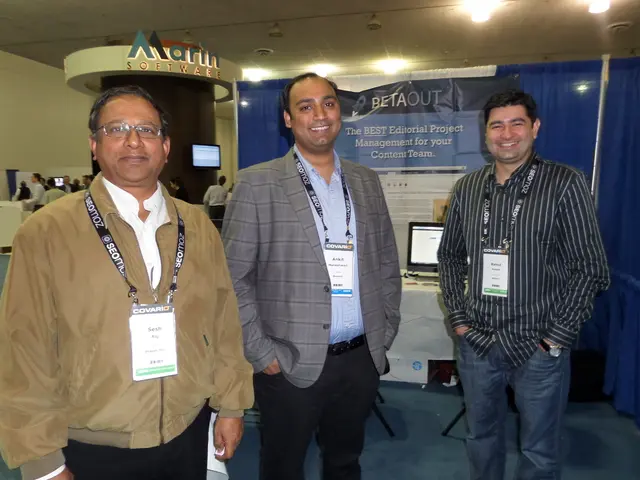IoT Solutions for Remote Healthcare: Exploring the Benefits
In the rapidly evolving world of healthcare, the pressure to enhance patient care while slashing costs is ongoing. One potential solution? Embracing Internet of Things (IoT) technology in healthcare settings. By incorporating these smart devices, we can monitor patient vitals, track medication adherence, and timely detect health risks. This information then boosts personalized patient care, enhances patient satisfaction, and even supports remote monitoring.
While IoT technology offers numerous benefits for healthcare, it's essential to acknowledge the technology is still in its infancy. Challenges, such as securing patient data and ensuring privacy, must be addressed before IoT can truly revolutionize the healthcare sector. Despite these hurdles, the potential benefits are too tantalizing to ignore. IoT technologies have the potential to elevate patient care while reducing healthcare costs. As the Internet of Things (IoT) continues to develop, it's likely more healthcare facilities will embrace IoT and other technologies to improve remote patient monitoring.
Trends in IoT for Healthcare
The integrative power of IoT technology can significantly impact healthcare, enabling connected devices to collect and analyze data in real-time. This real-time data can be used not only to monitor specific symptoms but also to alert healthcare professionals as necessary. In essence, this establishes the framework for Internet of Medical Things (IoMT), enhancing both physical and digital healthcare systems.
IoT devices can be utilized to monitor vital signs, schedule routine check-ups, and identify patterns that might indicate an illness. This proactive approach allows for the prevention of recurring health problems and chronic diseases, such as diabetes, hypertension, and stroke. By employing IoT technology, healthcare facilities can evolve into smart facilities, which promise reduced costs, enhanced patient care, and more effective disease management.
IoT Healthcare Applications
The integration of IoT technology in healthcare is already redefining services, altering management practices within healthcare systems. IoT technologies have already become standard in industries like manufacturing, transportation, and healthcare. In fact, healthcare is poised to gain the most from IoT technology due to its ability to support continuous monitoring of elderly patients, boost medical research, monitor medical tools, optimize healthcare provider workflows, and automate proactive treatment plans. Mobile applications can even play a key role in disease monitoring and prevention. With IoT in healthcare, medical care facilities can elevate patient treatment outcomes while cutting costs.
Remote Patient Monitoring
Beyond offering healthcare assistance to patients in remote locations, remote patient monitoring can similarly support patients dealing with complications in pregnancy or chronic illnesses. When a patient seeks remote monitoring, a healthcare service will provide the necessary medical equipment (wearable sensors or other real-time health monitoring devices) and explain their usage. Once in place, the clinician will receive alerts regarding changes in the patient's required health data. The clinician can then communicate with the patient and adjust treatment accordingly. In a study, remote patient monitoring was found to decrease hospitalizations by 30% and save an average of $8,000 per patient.
Implementing remote health monitoring systems is advantageous, as it enables patients to stick to their treatment plans and receive better care. Implementing IoT in healthcare also benefits physicians, as they can analyze patient data and strengthen relationships with patients. By fostering remote health monitoring, doctors can observe whether patients are following their recovery plans and whether their treatments improve their quality of life. By providing patients with IoT-based healthcare services for real-time monitoring, caregivers can enhance their relationships with patients and gather pertinent medical data without constantly visiting them.
Proactive Treatment
Embracing the philosophy of "care beyond the hospital walls," IoT application in healthcare supports remote populations and bridges healthcare gaps through proactive care and problem prevention. These proactive teams consist of nimble problem-prevention experts who interact with patients frequently, bolstering the accuracy of medication adherence and data submission, thereby reducing errors. Proactive teams comprise interdisciplinary professionals who work cohesively to promote wellness across healthcare facilities.
Proactive treatment teams, equipped with smart cameras, wearable healthcare devices, and other smart devices, encourage patients to self-monitor and share sensitive data to a central data center, arrange for outpatient visits, and schedule follow-up lab tests. Proactive care software can benefit health insurance companies as well, as it promotes healthy habits that last a lifetime and positively impact a patient's health status. With IoT in healthcare, medical professionals can intervene before a problem worsens, causing significant complications. In short, the impact of IoT in healthcare is profound, as it boosts overall patient health through problem prevention and encourages patients to take responsibility for their health.
Medical Equipment Monitoring
Medical equipment monitoring is a critical component of remote patient monitoring. This system involves collecting patient medical data from various electronic devices, such as handheld instruments and wearable sensors, and transmitting the information to a healthcare provider in another location for assessment. In remote locations where infrastructure is limited and resources are scarce, this support is crucial.
IoT Challenges in Healthcare
While the use of IoT in healthcare offers numerous technological advances, several challenges must be overcome to facilitate widespread adoption. One significant hurdle is adapting to a new system and digital form of treatment, particularly for rural hospitals which face massive investments to adapt. However, the potential benefits will ultimately outweigh the initial investment. With IoT ecosystems, the quality of care, efficiency of processes, and cost savings will outweigh the costs of implementation. Monitoring IoT devices must seamlessly integrate into healthcare workers' workflow to ensure they provide the best possible care.
IoT Impact on Treatment Outcomes
IoT can improve treatment outcomes by continuously monitoring patient health parameters. In doing so, hospitals can optimize treatment systems and unlock new opportunities in healthcare. Through the proper utilization of IoT, medical students can improve their diagnostic skills, and IoT can resolve various challenges within the healthcare sector, such as speed, cost, and complexity.
IoT technology can improve health management and monitoring in hospitals, allowing for more effective treatment. It can also be incorporated into other applications, such as hearing aids and fitness trackers, providing health check systems, minimizing manual data collection and record-keeping costs, and facilitating disease monitoring and prevention. By utilizing IoT in healthcare, medical facilities can elevate patient care quality while cutting costs.
Website Devices for Healthcare
[Our website] is a leading manufacturer and designer of End-to-End IoT solutions, gateways, and devices in various sectors. Our comprehensive line of healthcare solutions revolutionizes how patients, residents, and healthcare facilities are monitored. Our healthcare solutions cover various aspects, including respiratory health to vital sign monitoring, transforming the way we manage chronic illness and health hazards. IoT devices from [our website] offer ease of setup, minimal maintenance, and continuous monitoring capabilities, offering the potential to change the way we practice medicine.
For remote healthcare settings, [our website] has developed a wearable device called [eDOCTOR], which continuously monitors a patient's temperature, breathing rate, chest expansion, body position, and heart rate. Ideal for individuals dealing with chronic respiratory-related illnesses, seniors, athletes, and military personnel, [eDOCTOR] provides constant connectivity and an impressive battery life of over three months. [eDOCTOR] is fully integrated with the [our website] Respiratory Sensor Desktop Application, allowing you to view all data and receive notifications of urgent events requiring medical attention.
Another device from [our website], which can improve healthcare, is [eBEAT]. The device continuously monitors the patient's vital indications, including body temperature and heart rate. Primarily used for patients dealing with respiratory illnesses, [eBEAT] can detect symptoms of chronic illness. The device can discreetly be worn and is adjustable and washable, fitting any size.
Things to Remember
Many remote areas around the world lack adequate healthcare access. Factors contributing to this shortage include a lack of trained medical professionals, inadequate infrastructure, and limited resources. By integrating IoT devices from [our website], healthcare facilities can help improve access to quality healthcare for individuals in remote areas worldwide. To initiate the integration of IoT devices into your healthcare institution, please contact [our website]'s sales and support team at info@our website.
Piccini, J. P., Mittal, S., Snell, J., Prillinger, J. B., Dalal, N., & Varma, N. (2016). Impact of remote monitoring on clinical events and associated health care utilization: A nationwide assessment. Heart rhythm, 13(12), 2279-2286.
IoT devices from [our website] can be utilized to monitor vital signs, schedule routine check-ups, and identify patterns that might indicate an illness. This proactive approach enhances both physical and digital healthcare systems, contributing to the framework of the Internet of Medical Things (IoMT). In essence, these devices support remote patient monitoring for individuals in remote locations, helping bridge healthcare gaps. (Trends in IoT for Healthcare)
As more healthcare facilities embrace IoT, the potential to implement proactive treatment becomes a reality. Proactive teams equipped with smart devices encourage patients to self-monitor and share sensitive data, reducing errors and promoting wellness across healthcare facilities. (IoT Healthcare Applications)
However, to ensure IoT can truly revolutionize healthcare, challenges such as securing patient data and addressing privacy concerns must be addressed. Despite these hurdles, the benefits of IoT technology are too tangible to ignore. IoT devices from [our website], such as [eDOCTOR] and [eBEAT], offer ease of setup, minimal maintenance, and continuous monitoring capabilities, offering the potential to change the way we practice medicine for the better. (IoT Challenges in Healthcare)




